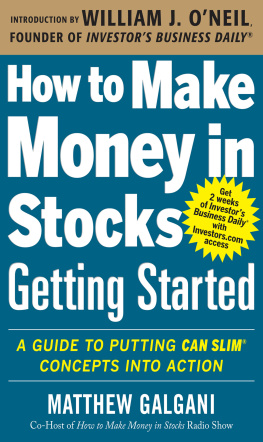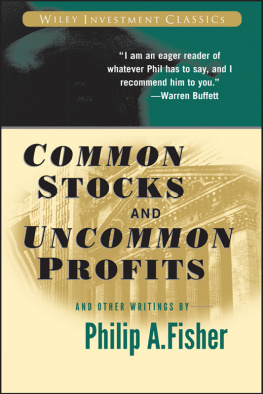
The Simple Truth About Investment Profits
Tan Liu
QuantStyle LLC
Delaware
Copyright 2017 by QuantStyle Publishing
www.ThePonziFactor.com
Published in the United States by
QuantStyle Publishing
Lewes, Delaware 19958 US
eBook Design 2017 QuantStyle Publishing
ISBN 978-1976949951
The Ponzi Factor: The Simple Truth about Investment Profits/ Tan Liu. 1st ed.
All rights reserved. This ebook may not be reproduced in any form without permission in any form without permission, except in the case of brief quotations embodied in critical reviews and certain other noncommercial uses permitted by copyright law.
The Ponzi Factor is a nonfiction ebook that describes what the Author witnessed and observes in the investment finance industry. The majority of the data and statistics are from first hand sources. This ebook is distributed with the understanding that neither the Author or Publisher is rendering any legal or other professional advice. The Author and Publisher disclaims any liability.
CONTENTS
Truth
All truth passes through three stages. First, it is ridiculed. Second, it is violently opposed. Third, it is accepted as self-evident.
Arthur Schopenhauer
INTRODUCTION
The Most Dangerous Ideas are those that are True
Read the literature, but dont read too much of it. Read a bit to notice something that everybody is doing wrong. Something that just doesnt feel right. Read enough to develop your intuitions, and then trust your intuitions. Dont be too worried if everybody else says its nonsense.
But, there is one thingIf you think it is a really good idea, and other people tell you its COMPLETE NONSENSE. Then you are really onto something.
Geoffrey Hinton
For A Moment, Ignore Everything You Know About Stocks , the investment system and everything that took place over the past 400 years. Imagine yourself in the early 1600s at a time when no one knew what stocks were yet, but they were about to be introduced as a new investment instrument. Youre going to hear two proposals, and I want you to think about how the early investors would have reacted to the introduction of stocks.
Proposal One:
A business owner approaches a group of investors and says, Im selling shares of my company. If you invest in my business, youll receive a note that says you own a piece of the company, and if the business makes money, youll receive a share of the profits. The note is transferable, so you can also sell it to other investors. If youre lucky, you might even receive more than you paid.
Proposal Two:
A business owner says to a group of investors, Im selling shares of my company. When you invest, youll receive a note that says you own a piece of the company. However, you wont receive any money from the business, and the company is not obligated to pay you anything, ever. But, you can make money by selling the note to other people. You might get lucky and get more than you paid.
Now, which proposal do you think early investors would have considered, and which do you think they would have avoided? Which one sounds like a legitimate business investment, and which one sounds like a shady scam?
History shows that when stocks were first introduced to investors, they were designed to perform like investment proposal number one, where companies paid dividends and shared profits with investors. But today, the common stocks that are being issued to investors behave like proposal number two, where shareholders receive nothing from the business, and the only realistic way investors can make money is by selling their shares to other investors.
One of the biggest myths about stocks is the idea that profits from stocks come from the earnings and growth of the underlying company. The assumption is, when a company makes money, they share the profits with their investors. But in practice, most public companies never pay dividends, and when they make money, which can be millions or even billions, they keep everything.
The reality is, profits from stocks come from other investors who are buying and selling stocks. When an investor buys a stock for $10 and sells it for $11, that $11 comes from another investor, someone who will then start hunting for yet another investor who will give him or her $12, and so on.
This is actually a negative-sum situation because the underlying company isnt involved in the transaction. The investors are just cannibalizing each other for profits, and there are fees attached to every transaction.
Its one thing if everyone acknowledges this negative-sum gambling scenario and people just want to gamble. But the stock market is sold as a positive-sum investment system, and investors believe the system produces more money than they contribute. This is why most of the money that goes into the stock market comes from pension plans and retirement funds, and why 18-year-old kids are allowed to open online trading accounts.
Finance professionals will rationalize that its not all about the cash, but also about investing in the hypothesized intrinsic value of the companies, and point out how the US stock market has grown to more than $30 trillion in value. Now, this would be a valid argument if we lived in a world where investors buy stocks for the sake of having stocks and never want their money back. But the last time I checked, investors do want their money back. People dont buy stocks because they love stocks and think: I love my shares of Google. I want to hold their stock forever and never get my money back.
No. Investors buy stocks because they want to make moneyand their only objective is to get more cash out of the system than they put into it.
Investment finance is different from other businesses because everyone involvedfrom the bankers to the analysts, to the advisors, to the investors and the companies that need investmentsall want one thing and one thing only: cash. This is not the case when we look at a normal business like a restaurant. The restaurant that sells food wants cash, but the people who give the restaurant cash are end-users who want food in return, not more cash. This simple and essential fact is why the logic of investing is incredibly illogical.
When it comes to stock transactions, the person selling the stock wants cash, but so does the person who is buying the stock. There are no end-users. Everyone involved wants more money back than they contribute, and no one pays attention to where the money is coming fromIts probably because no one wants to know where the money is really coming from.
The problem is, the money investors take out of the system is coming from other investors who are putting money into the system, and the stock market is just a system that shuffles cash between investors. It is a system where current investors profits are strictly dependent on the inflow of money from new investors. And, such a system is also known as a Ponzi scheme.
Most people understand that a Ponzi scheme is a scam, but what most people dont realize is that a Ponzi scheme can also produce a lot of winners. Its not a scam where everyone loses money. A lot of investors who are involvedand unaware of the scamcan make money too. Bernard Madoff ran the biggest Ponzi scheme to date. After his $50 billion scam was exposed in 2008, investigators found that more than half of his accounts showed a profit. The total amount of money lost in his scam was greater of course, but as far as the accounts were concerned, more than half of them actually showed a net profitas in, those accounts withdrew more than they contributed.
The fraudulent aspect of a Ponzi scheme is not its inability to produce winners. The issue is in the mechanics and where that money comes from, and how investors who make money are taking it from other investors who also want to make money.
Next page










